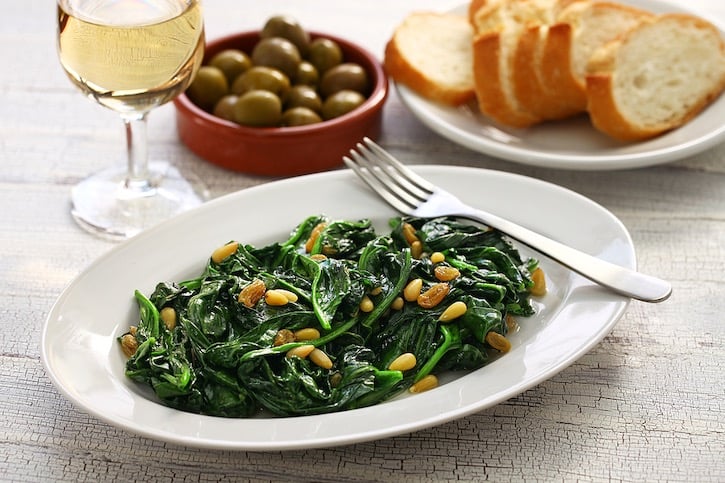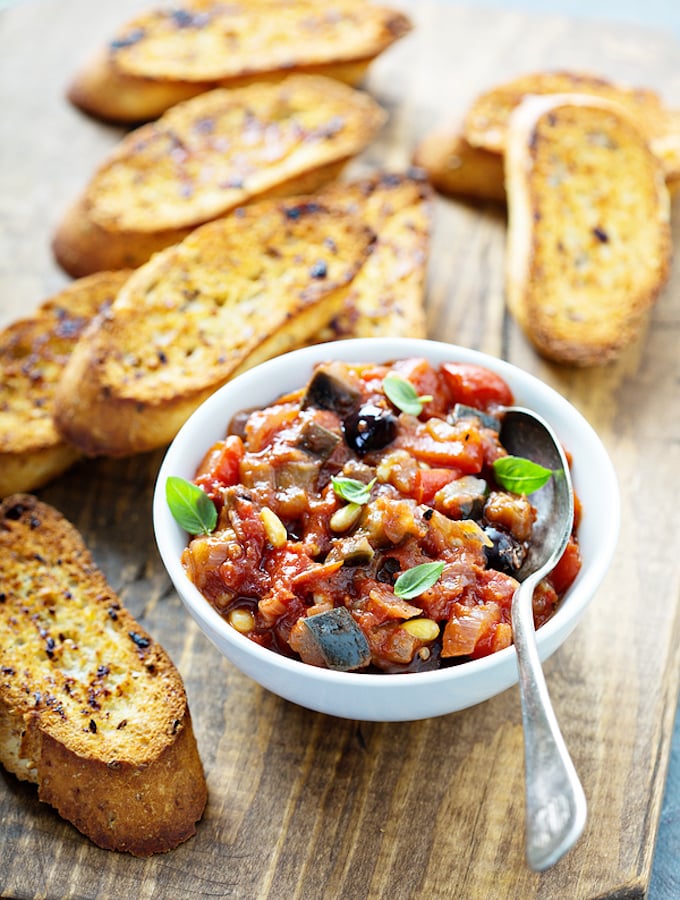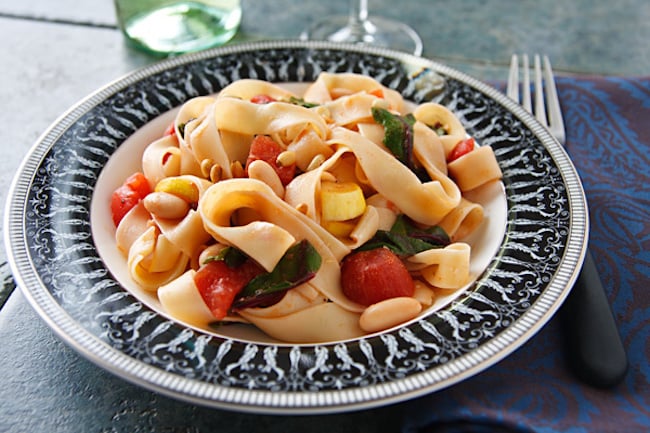Here’s a quick guide to pine nuts — the rich, diminutive delicacy with Mediterranean roots, with tips on buying, toasting, and using in recipes.

Pine nuts are expensive, but with their rich and intense flavor, a small amount goes a long way. Most of the time, pine nuts are sold untoasted (or put another way, not roasted).
While they can be used raw, toasting is highly recommended. The tangy, somewhat “piney” flavor mellows into melt-in-your-mouth deliciousness. We’ll get to that shortly.
What are pine nuts, and where do they come from?
Pine nuts are the seeds found in the pinecones of certain species of pine trees. They have achieved the rank of a delicacy. The pinecones are heated to help open them, then the nuts are removed by hand. The type most commonly found in natural-food and specialty stores is the pignolia, from the tree Pinus pinea, and is imported from Italy, Spain, or France.
A somewhat different variety, the piñon, from the piñon tree, is used in the indigenous cuisines of North and South American and Mexico. In North America, the piñon is rarely marketed commercially outside the Southwest, so the comments in this entry pertain to pignolias.
Pine nuts are commonly used in Mediterranean cuisines, particularly those of Italy and Greece. In Greek cuisine, they’re sometimes used to stuff grape leaves or in pastries. In their native regions, they’re also used as a snack to be eaten out of hand.

How to buy and store pine nuts
Some of the oils present in pine nuts go rancid quickly, so they’re best kept refrigerated in airtight containers at all times. Assuming you purchase them at optimal freshness, they’ll keep for 3 months in the fridge and 6 to 9 months in the freezer.
Whether you buy them in bulk or packaged, make sure they’re from a source that has a good turnover.
Pine nuts can be found in well-stocked supermarkets, natural foods stored, and Mediterranean groceries. You can also compare prices at online sources such as nuts.com, and some big box stores like Walmart and Target.

How to toast pine nuts
While you can certainly use pine nuts without first toasting, doing so enhances their rich flavor. Here’s how they should look toasted, above.
On the stovetop (preferred): Simply spread pine nuts on the surface of a dry skillet and cook over medium-low heat, stirring often, until touched with golden brown. This will take between 5 and 8 minutes roughly, but much depends on the type of skillet and the exact amount of heat applied.
In the oven: Spread pine nuts in a single layer in a roasting pan. Bake at 350º F. for 5 to 10 minutes, stirring every couple of minutes, and watching carefully.
Nutrient profile of pine nuts
The fat content of pine nuts is 47.5 percent. There’s a roughly equal amount of monounsaturates and polyunsaturates, with only a small proportion of saturated fats. One once contains 19 grams of fat.
Pine nuts are 25 percent protein. One cup contains about 700 calories; 1 ounce contains 156 calories. Pine nuts are plentiful in the minerals iron, potassium, phosphorus, and zinc. They contain modest amounts of several B vitamins.
Here’s more about the nutrient profile of pine nuts.

Ideas for using pine nuts
Pesto: Pine nuts are commonly used in making pesto. If you come across a standard pesto recipe that calls for walnuts rather than pine nuts, you can simply swap in an equal amount of pine nuts, preferably toasted. Try this 5-minute Easy Vegan Pesto.
Green veggie garnish: Use toasted pine nuts as a garnish, sprinkled over green vegetables — broccoli, leafy greens, Brussels sprouts, asparagus, and green beans.
A green salad enhancer: Pine nuts make any simple green salad shine. Try this: Combining a cup or so of halved seedless green or red grapes, 1/4 cup toasted pine nuts, and a tender lettuce such as red leaf or Bibb as needed, and sliced Belgian endive. Dress in a mild vinaigrette or raspberry vinaigrette.
All kinds of salads: A handful of toasted pine nuts adds a richly flavored flourish to grain salads, kale salads, pasta salads, and potato salads.
Vegan stuffings: Add 1/4 to 1/3 cup toasted pine nuts to vegan stuffings for an extra-rich flavor element.
Homemade vegan cheeses: Pine nuts can be used in place of cashews to make extra rich-tasting vegan cheeses. Raw Vegan Pine Nut “Goat Cheese” is one such recipe.
Casserole and risotto garnish: Use as a garnish for casseroles — they’re especially welcome atop baked risotto.
With wilted greens: A handful of toasted pine nuts is a great topping for any simple dish of wilted leafy greens like spinach, kale, chard, or broccoli rabe. A classic Mediterranean side dish combines garlic sautéed in olive oil with wilted greens (usually spinach), plus a small amount of raisins and toasted pine nuts.
A classic addition to pasta dishes: Toasted pine nuts are especially welcome in pasta dishes, particularly those using mild sauces or simply dressed with olive oil.
Here’s one idea: Combine 8 to 10 ounces of pasta twists (cooked) with steamed chopped broccoli florets (from1 large or 2 medium crowns) with and 1/4 cup toasted pine nuts. Add extra-virgin olive oil, salt, pepper, and finely chopped fresh basil as desired and toss together. This makes about 4 servings.
Avocado toast: Sprinkle your avocado toast with a few toasted pine nut to make a rich sandwich even better.
On hummus: Make a great spread even better with a generous topping of toasted pine nuts.
Cookies: There’s a famous Italian recipe called pignoli cookies. Here’s a vegan recipe for this classic treat.
Vegan recipes using pine nuts

Mediterranean Spinach with Pine Nuts & Raisins

Brussels Sprouts with Chard or Other Leafy Greens


Pasta with Chard and White Beans
Here are more delectable vegan recipes using pine nuts from around the web:
- Quinoa Salad with Asparagus, Sun-dried Tomatoes, Olives & Pine Nuts
- Easy Oven-Baked Tomato Risotto
- Raw Vegan Red Pepper Basil Creamy Pine Nut Pesto
- Vegan Lemon Pasta with Pine Nuts and Broccoli
See more of this site’s Good Food Guides.

How can you exclude one of the most common sources of pine nuts, the variety grown in China, Russia and Korea? It appears that is what you have in your pictures. It is shaped like candy corn. The good Mediterranean stuff is shaped like long jelly beans. Many peoole have a bad reaction to the Chinese variety that leaves a metallic taste in the mouth, sometimes for days. There are bad vegetarian foods, too.